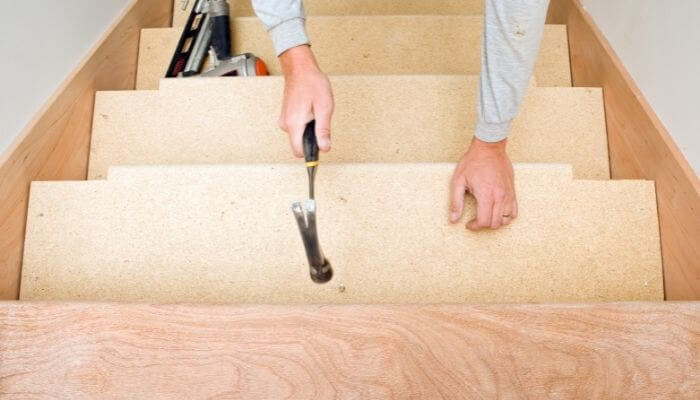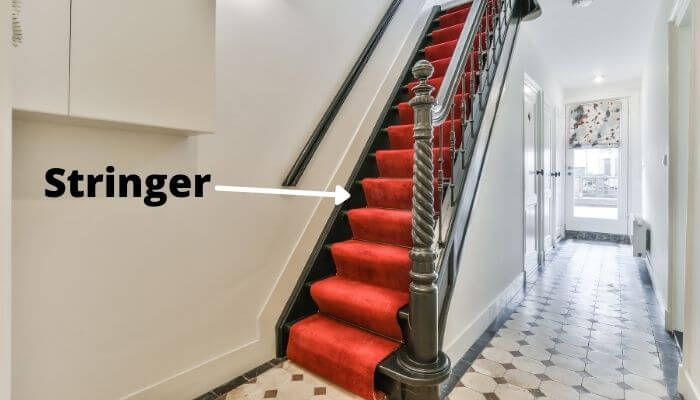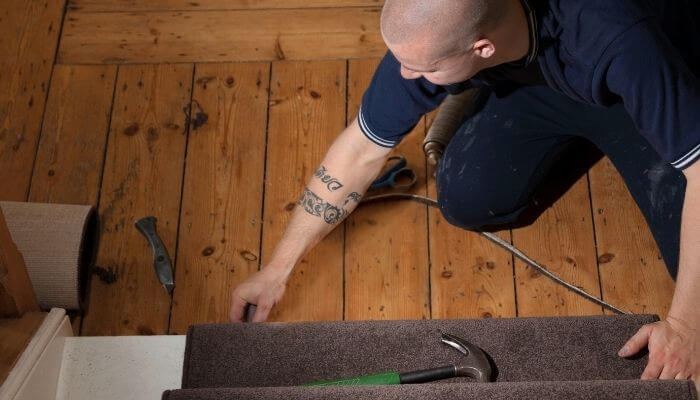Wooden stairs are a common feature in multi-story houses. They are also commonly known to be squeaky, creaky, and just downright noisy.
The main reason for squeaky stairs is general wear and tear and aging.
As the timber of the stairs ages, it shrinks.
With this, the tread of the stairs may begin to rub against the top of the risers when weight is applied.
This friction results in the creaking we hear when we step on a stair.
Please note: this article is about reducing squeaking noises on your stairs, if you want to fully soundproof your stairs we have a different article you can read.
Fortunately, there are numerous things you can do to make your stairs quieter:
1. Use Powder On The Cracks In The Stairs
The first way to quieten the creaky noise stairs make is to use powder to fill the cracks of the stairs.
When building stairs, there are inevitably going to be gaps and cracks between the wood.
The space of the cracks can lead to the wood moving into that open space and rubbing against another part of the wooden stairs.
The friction of the wood rubbing against other wood is what causes the stairs to creak and be noisy.
These types of creaks most often come from the back of the stair or the sides of the treads.
These are the places that most commonly have a gap or crack between the pieces of wood used to create the stair.
This squeaky problem can be solved by simply filling the cracks in the stairs with powdered lubricant.
The ideal types of lubricants that should be used are talcum powder or powdered graphite.
Using a powdered lubricant will fill the gaps and cracks and therefore eliminate the empty space between the pieces of wood.
With something filling this space, the wood pieces cannot reach each other and rub together, therefore removing the squeaky noise.
Never use an oil-based lubricant on your wooden stairs.
Oil-based lubricants damage the wood by warping it.
They may also turn sticky with the collection of dust or even become slippery.
2. Nail The Treads Down Into The Risers
When wood ages, it shrinks, which can result in spaces between the various parts of the stairs that were not there before.
These spaces leave room for the wood to move and create friction against other parts of the stairs. This friction, in turn, results in an annoying creak.
The most common places for space to be created are between the tread and the riser of the staircase.

The tread of a staircase is the flat, horizontal part of the stair that you step on.
The riser, on the other hand, is the vertical piece that supports the tread of the stairs.
When you step on the front of the stair where the tread meets the riser, if there is space between the two pieces of wood, the stair will squeak with the pressure.
To remove this type of squeak, all you need to do is remove the space between the tread and the riser.
This is just as easily done as it is told.
All you will need to do is nail the tread down into the riser.
This is the best solution to your creaky problem if your stair squeaks at the front of the tread.
To nail the tread of your stair into the riser, you will need two, three-inch finishing nails per step, a hammer, a drill, wood putty the same color as your stairs, and something to make some small distance marks with, such as a pencil.
- Mark two spots on the tread of your stair where you will be placing the nails. Make sure your marks are far enough away from each other so that your nails do not intersect each other.
- Use your drill to make holes in your marks. These holes will act as the starter holes for your nails. Ensure that the drilling bit you use is smaller than the diameter of your finishing nails.
- Once this is done, hammer the finishing nails into the holes until the heads are just lower than the surface of the tread. Angle the nails at 60 degrees so that they remain flush, even over time. The nails should be angled so that they point towards each other.
- Use a wood putty that matches your stairs to fill the dents and cover the heads of the nails. Repeat these steps for every step with a creaky tread.
3. Use Corner Blocks Under The Stairs
If you have access to the underside of your staircase, putting corner blocks in place under the treads is an ideal way to stop your stairs from making noise.
Corner blocks are small, triangular blocks of wood that are screwed into the underneath of your stair’s treads and risers.
This is done to offer the treads more support and eliminate movement and therefore any creaky noises.
For this fix, you will need three corner blocks, also known as glue blocks, per stair, wood glue, two screws per corner block, and a drill.
- Put wood glue onto the two short sides of a corner block. Place it into the corner of the joint of the step with the glue pressed up against the tread of the step and the riser. Repeat this step for the other two corner blocks, placing one in the middle of the step and one on the opposite end. Be sure to wiggle the corner blocks slightly when pressing them into place to displace any air bubbles in the glue.
- Next, once the glue has dried, drill two screws into the corner block for extra security. One screw should be going horizontally into the riser of the stair. The other screw should go vertically into the tread.
These steps will need to be repeated for each squeaky stair.
4. Tighten Up Stringers
The stringers of your stairs are the sawtooth-shaped boards that run up the side of the treads and the risers.
The stringers are what keep your staircase together and offer it support.
Occasionally, the stringers on your staircase may become loose.

When this happens, when you apply pressure near the back of the tread, the stair is likely to squeak from the friction between the wood.
To fix this problem all you need to do is tighten up the stringers.
For this, you will need something to mark your stairs, such as a pencil, a drill, four three-inch nails per step, a hammer, and some wood putty the same color as your stairs.
- Firstly, mark your two starter holes on the side of the tread above the stringer. Do this on the opposite side too.
- Next, drill your starter holes on your marks at a 45-degree angle. Be sure to angle the holes away from each other. The size of your drill bit should also be slightly smaller than the diameter of your nails.
- Once your starter holes have been drilled, hammer the nails into each hole at a 45-degree angle. Angling the nails like this will create a clamp that will hold the stringer and tread in place and the nails will not wiggle loose over time. Make sure you hammer the head of the nail lower than the surface of the tread.
- Finally, fill the gap and cover the head of the nail with wood putty that matches the color of your stairs.
5. Fit Thick Carpet
Sometimes, your stairs may not necessarily squeak but are still noisy when walked on.
This noise is likely a result of the heavy footfall that pounds against each step daily.
One way to dampen the sound of footfall on stairs is by fitting carpeting.
Throws, rugs, or carpets have brilliant qualities for absorbing sound.

By laying carpeting down on the stairs, it will work to absorb the sound vibrations created when walking up and down the steps.
The thicker the carpet that is placed, the better sound-absorbing qualities it will have.
The added benefit is that carpeted stairs are safer for the elderly as well as children.
You do not want to go with a carpet that is too thick as this will be a potential tripping issue.
When done correctly carpeted stairs look great and are silent.
Final Thoughts
Staircases can be a real pain, especially when every step you take gets louder and creakier than the next.
Thankfully, there are a few simple things we can do to make our stairs quieter and relieve ourselves of the frustratingly squeaky noises.
A task as simple as laying a carpet on your stairs can reduce the noise carried through your house from your staircase.
For a more permanent solution, you could also do a few simple modifications such as tightening your stair’s stringers with a couple of nails.
To find the best solution to your noisy stair problem, however, is to determine where exactly the creak is coming from when you step on your stair.
Then you will be able to put a modification in place that will hit the nail on the head and shut your squeaky creak up!
As an Amazon Associate I may earn a small fee from qualifying purchases at no extra cost to you. This helps us run the site, so thanks for your support!
